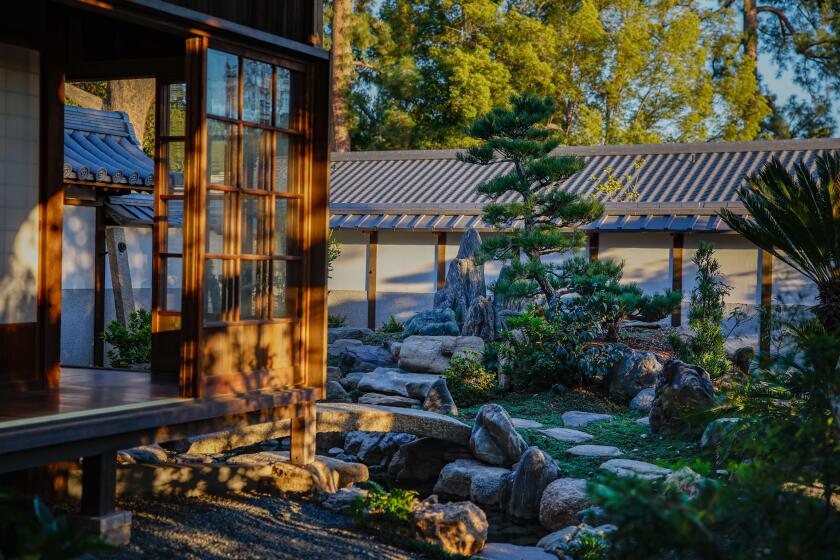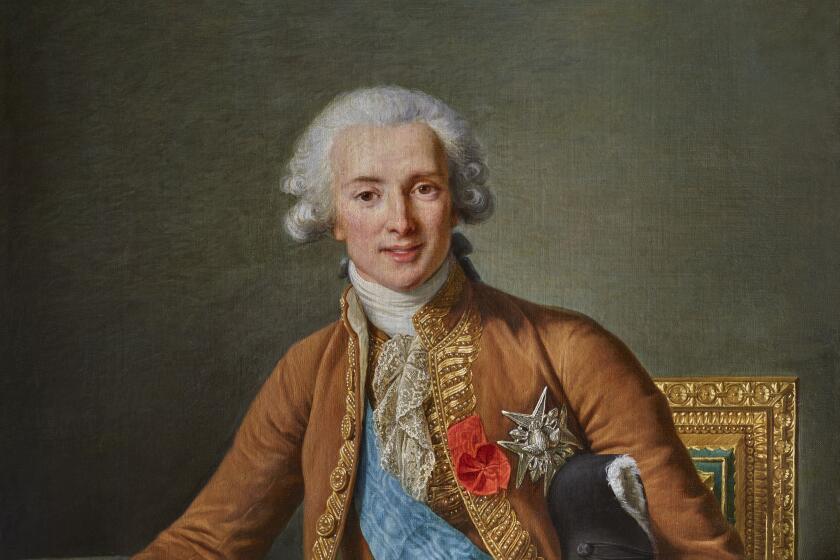The Huntington was gifted four major paintings this year. They fit like a glove
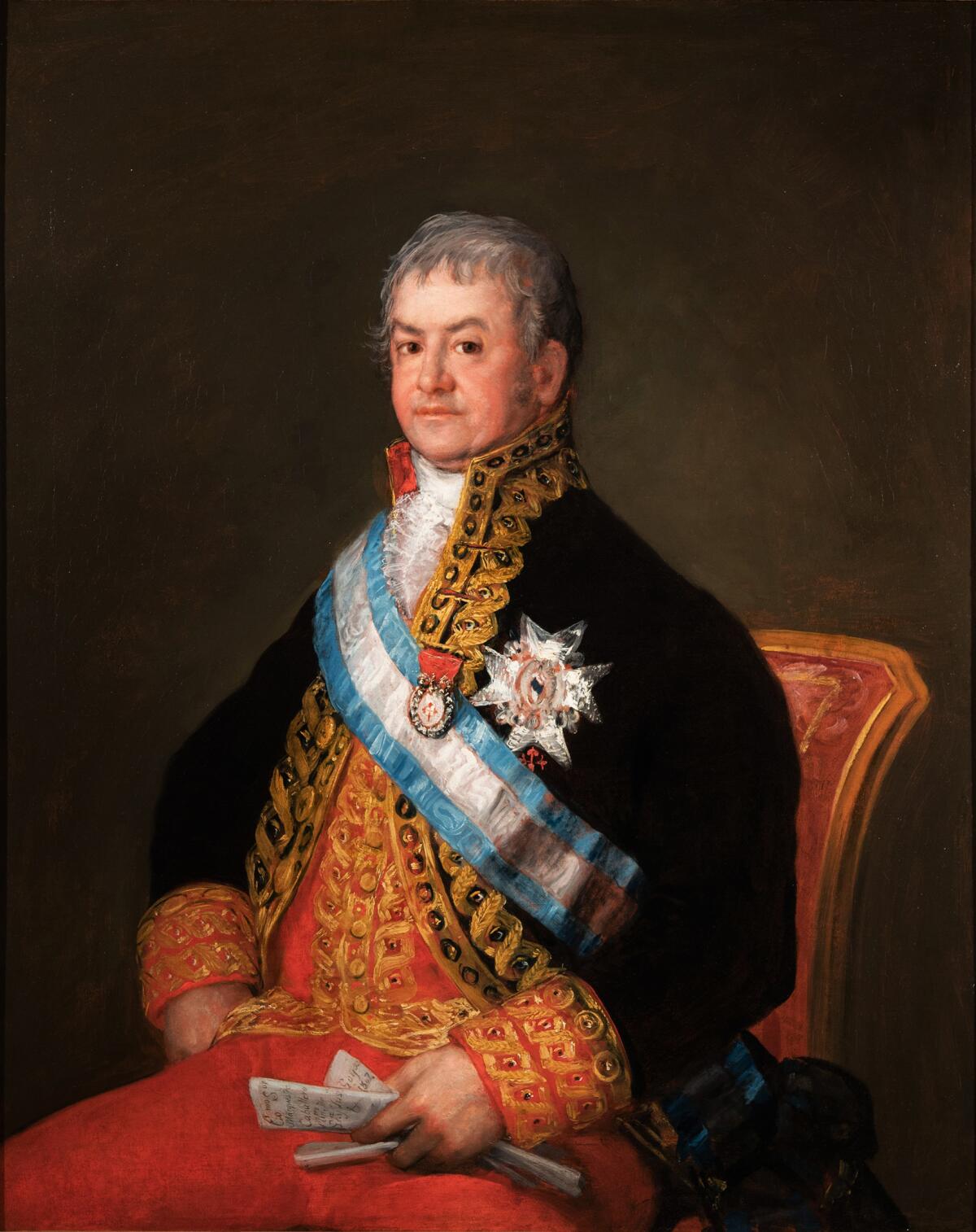
- Share via
Four significant paintings were donated to the Huntington Library, Art Museum, and Botanical Gardens in 2023. They fit the collection like a glove, while expanding its purview as well.
The most recent — and grandest — is a flamboyant portrait by Francisco de Goya, now on view in the mansion. Spain was in the midst of growing turmoil when Goya painted his portrait of José Antonio Marqués de Caballero in 1807. As the Napoleonic Wars unfolded, it was hard to keep track of the shifting alliances between Spain, England, Portugal, Prussia, Austria, France and assorted small kingdoms, quaking in the wake of popular demands for reform unleashed by the French Revolution. The next year, Napoleon would boot Madrid’s royal family, his former ally, and declare his own brother, Joseph, king of Spain.
After a three-year closure and 18-month renovation, the Huntington Library, Art Museum and Botanical Gardens reopens its tea room with an outdoor addition.
Caballero was by all accounts smart, shrewd and a seasoned knife fighter in the corridors of power at the Spanish court, a minor noble and avowed royalist who maneuvered his way into increasingly powerful positions. He got a lot of plain people on his side too. Known for staunch advocacy of using a controversial new smallpox vaccination around the colonial empire — sound familiar? — the Marqués was made famous when the vaccine’s effectiveness saved untold lives. His popular celebrity helped protect him throughout the Napoleonic turmoil.
Goya’s painting is remarkable in that it is less a compelling picture of the man, although his features are softly presented, than it is a dazzling portrait of the man’s uniform. The regalia does the talking.
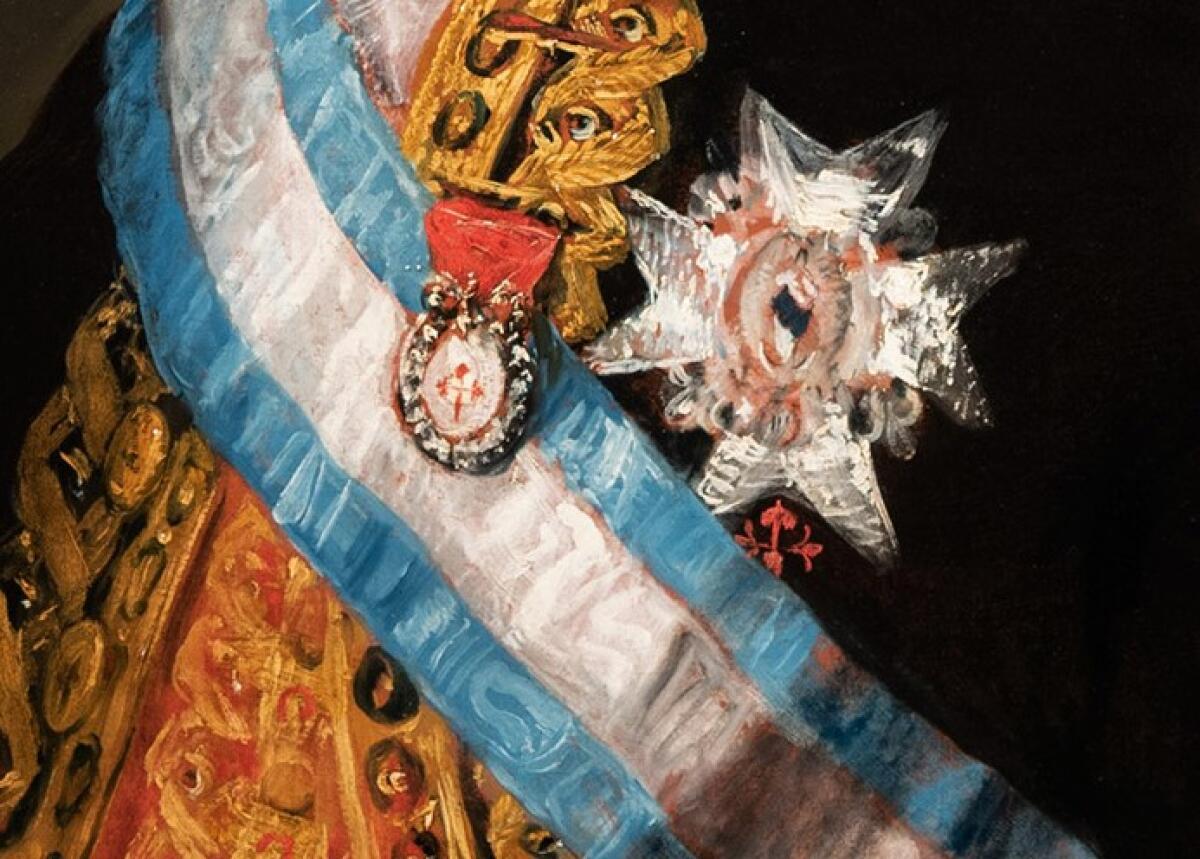
Agnolo Bronzino in Florence, Frans Hals in Haarlem, Hyacinthe Rigaud in Paris — lots of great European portrait painters exploited the language of wardrobe, but none more eloquently than Goya. Against the flat black expanse of the man’s jacket, he unleashed bravura brushwork to depict elaborate gold embroidery trim and buttons, a liquid blue and white sash in watered silk, a frilly sheer jabot falling from the throat and a small, enameled medal emblazoned with the crimson cross of the Order of Santiago.
Most spectacular is the adjacent white cross of the Order of Charles III. The highest civil honor granted by the king features the motto virtuti et mérito — virtue and merit — plus an image of the sin-free Virgin of the Immaculate Conception floating on a crescent moon. On Caballero’s blackened chest, Goya renders the white cross as a radiant explosion of light — kaboom!
Goya, of course, paints with astounding brilliance. In addition to the impasto fireworks, subtle red underpainting is glimpsed beneath the greenish brown color of the back wall and the black jacket, yielding smoldering life to what could have been just tired passages of dark flat color. Like warm coals, the hidden crimson hue seems to burst into full flame in Caballero’s scarlet breeches, vest and chair upholstery.
Visitors to the Huntington Library can tour a restored 18th century Shoya House, a residence from rural Japan.
For all the razzle-dazzle, however, you get the feeling that the artist is offering a bit of veiled amusement about the subject’s personal grandiosity. The guy is shown with virtually no shoulders, his sloping, triangular black jacket transforming his body into a veritable mountain, with the Marqués’ wispy smallish head perched like a cherry atop a hot fudge sundae.
His left hand clutches papers identifying his recently acquired rank and the right hand is hidden away, tucked behind his hip. Hands cost extra in a formal portrait’s typical commission, given the form’s time-consuming degree of difficulty and attendant labor costs. Maybe Caballero was just frugal, paying for only one. Or perhaps Goya is taking a small liberty, presenting parsimony in a sly juxtaposition to all that flashy gold embroidery, royal hardware and silk. The glittering uniform exalts Caballero, but a hand is just a hand — unless, of course, it’s the artist’s own hand, proudly displayed via all that eye-boggling brushwork.
The new acquisition is the better of two versions of the portrait, a slightly different one long installed in Budapest’s Museum of Fine Arts. (An unfinished copy by an unidentified artist is at Houston’s Museum of Fine Arts.) It’s a gift from the Ahmanson Foundation, whose advisor, J. Patrice Marandel, had searched to no avail for a substantial Goya oil during his 19-year tenure as chief curator of European painting and sculpture at the Los Angeles County Museum of Art. (LACMA, like the Huntington, has Goya etchings.) The Huntington museum’s founders, Henry and Arabella Huntington, originally had Goya paintings in their private collection, but those eventually went to Arabella’s son, Archer, an enthusiast of Spanish art and literature who founded the Hispanic Society of America in New York City.
It’s the third substantial Ahmanson gift, following major examples by Thomas Cole and Élisabeth Vigée Le Brun, after a 2020 falling-out between the foundation and LACMA. Installed now in Henry Huntington’s former wood-paneled office — unfortunately under glass — it’s a first-rate addition to the San Marino collection.
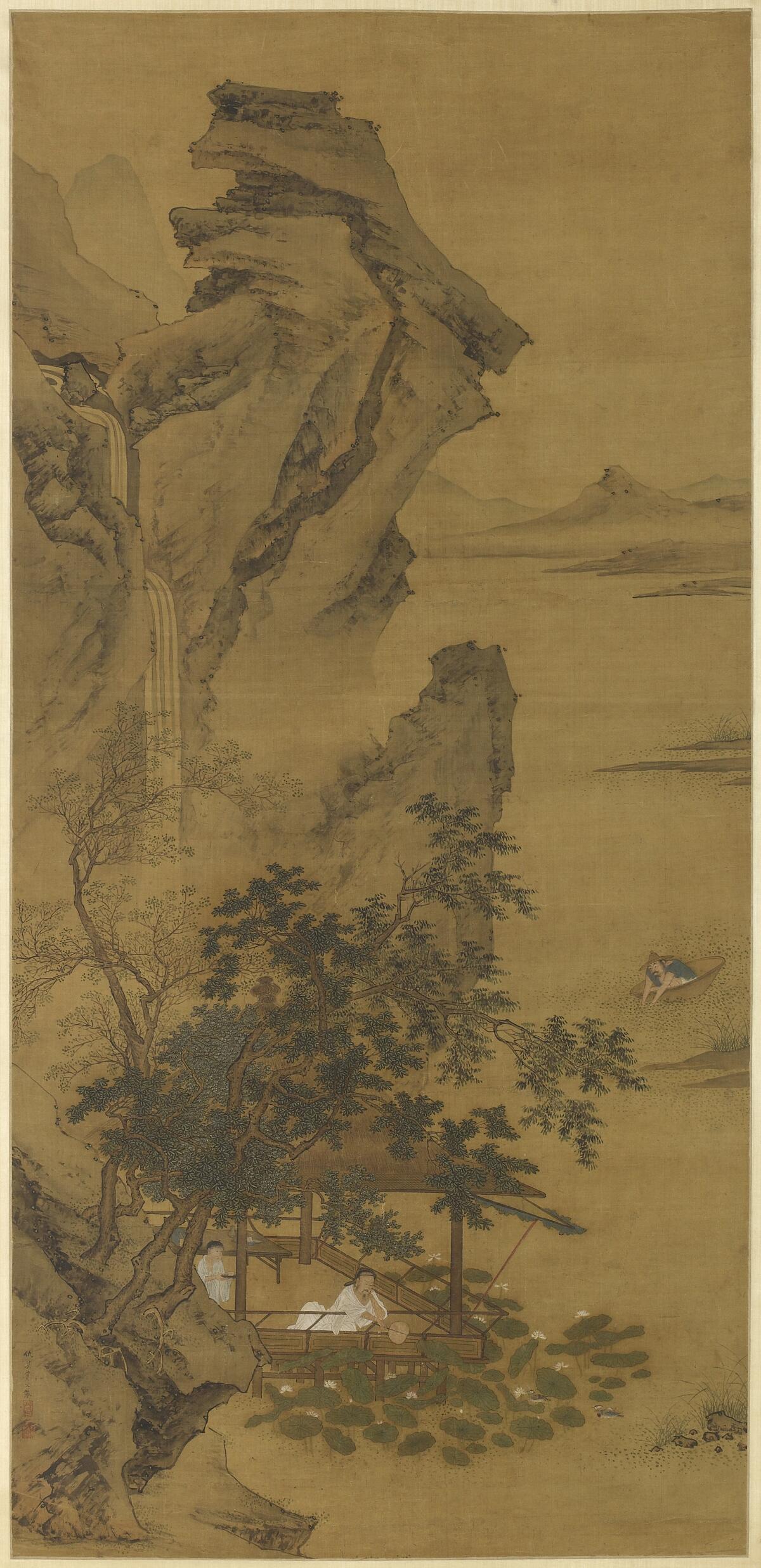
So is the limpid “Zhou Dunyi Admiring Lotuses,” an exquisite Qiu Ying scroll painting dated to the 1530s. Coincidentally, the Ming Dynasty master (circa 1495 to circa 1552) was the subject of a compelling LACMA retrospective — the first-ever assembled in the United States — which was shuttered by the 2020 COVID-19 shutdown a few weeks in, never to reopen. The Huntington painting, newly installed on the museum’s second floor, is a gift from trustee Simon K.C. Li (a former assistant managing editor at The Times) and his wife, June, founding curator of the Huntington’s Chinese Garden. On rotation for conservation reasons, it remains on view through March 4.
Nearly 4 feet tall and mounted on what the museum believes is the original silk floral-brocade backing, the beautifully preserved scroll shows Zhou Dunyi, a much-admired philosopher, idling in a lakeside pavilion, elbows resting on a railing as he takes in the lovely, aromatic sight of blooming lotuses, symbols of purity as they grow from watery mud. Behind him, a young servant arrives with a snack, while books and a celadon vase have been laid out for study on a nearby table. On the lake, a farmer in a small, basket-shaped boat harvests wild water vegetables, scooping them up with his hands.
The Ahmanson Foundation’s first major European art gift to the Huntington is a portrait by Élisabeth Louise Vigée Le Brun.
Qiu placed this considered scene of earthly delights, rendered in ink and mostly earth tones, at the foot of a dramatic landscape. A waterfall makes an orderly cascade from craggy peaks above, until it finally disappears into the lake behind the pavilion’s thatched roof. A cluster of four foreground trees, some just beginning to leaf, layer the space, yielding a perception that we’re arriving on a scene in late spring or early summer. (The lotuses signal June.) Sight, sound, touch, smell, taste — the senses — commingle with signs of work, whether the scholar’s contemplation or the farmer’s physical labor.
Qiu is something of a mystery man, although it is known that he was born to a peasant family near Shanghai. (The Huntington’s Chinese garden, Liu Fang Yuan — Garden of Flowing Fragrance — is based on classical-style examples from the same region.) Biography, however, is limited. The artist is best known for vibrant blue-and-green landscape paintings, but realist scrolls like this were also highly coveted. In fact, Qiu’s work became so popular after his death that he is generally considered the most-forged artist in Chinese history.
How does the museum know this donated beauty is authentic? The scroll was brought to the U.S. by a Chinese family in 1949, amid the turmoil around Mao’s revolution. Artists historically used multiple names, and the painting is signed at the lower left edge with four that Qiu employed. One is known only from a few other certified examples so it’s highly unlikely a forger would be aware of it.
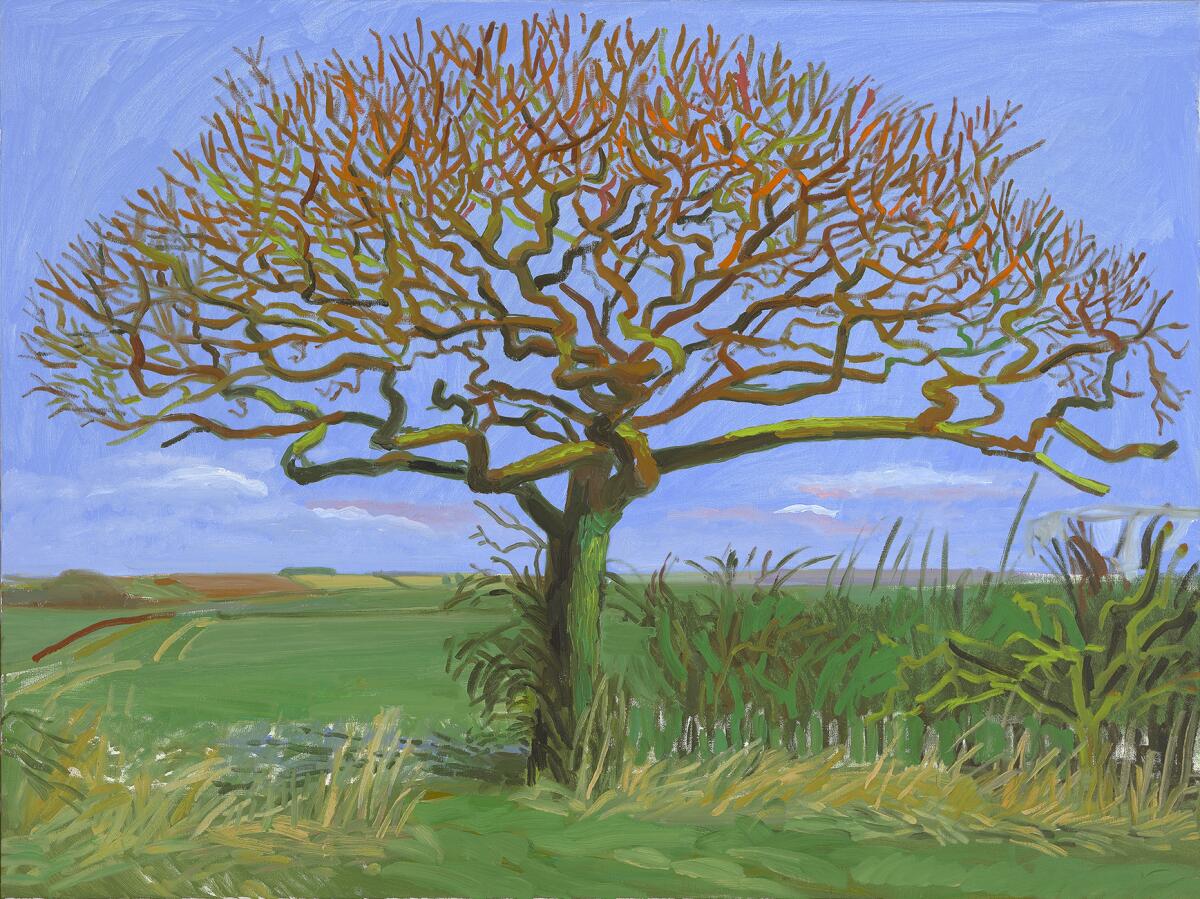
One room away, David Hockney’s “Tree on Woldgate, 6 March” (2006) is installed between two celebrated landscape paintings by John Constable. One is the diminutive “Salisbury Cathedral From the Bishop’s Grounds” (1823-1826), an imposing Gothic church seen framed through trees — a painting known in several versions. The other is the monumental “View on the Stour Near Dedham” (1822), arguably the greatest landscape in the museum’s celebrated British collection, picturing a barge and laborers working on a river during the booming industrial revolution.
The leafless Hockney tree, standing alone in a field beneath a pale blue sky and painted in bristling linear hues of brown, green, orange and pink, looks quite at home. As always, Hockney links tradition and modern abstraction.
The grandeur of a lone tree evokes continuity, a standard emblem in 19th century British landscape painting and photography. (“There’ll always be an England,” as the World War II anthem would later have it.) Constable wanted to give landscape subjects the stature of history painting so he constructed nature as a historical motif of English industriousness. Hockney’s lively linear tangle of limbs and branches — that look oddly like a diagram of a brain — pushes the painting legacy forward, encapsulating gestural abstraction from Jackson Pollock in the 1940s to Brice Marden in the 1980s.
“Tree on Woldgate, 6 March” was a gift from Gregory Evans, Hockney’s former romantic partner and longtime studio manager. It is dedicated to the couple’s late friend, Dagny Janss Corcoran; given the great Huntington Library, remembering a celebrated dealer in art books is an added grace note.
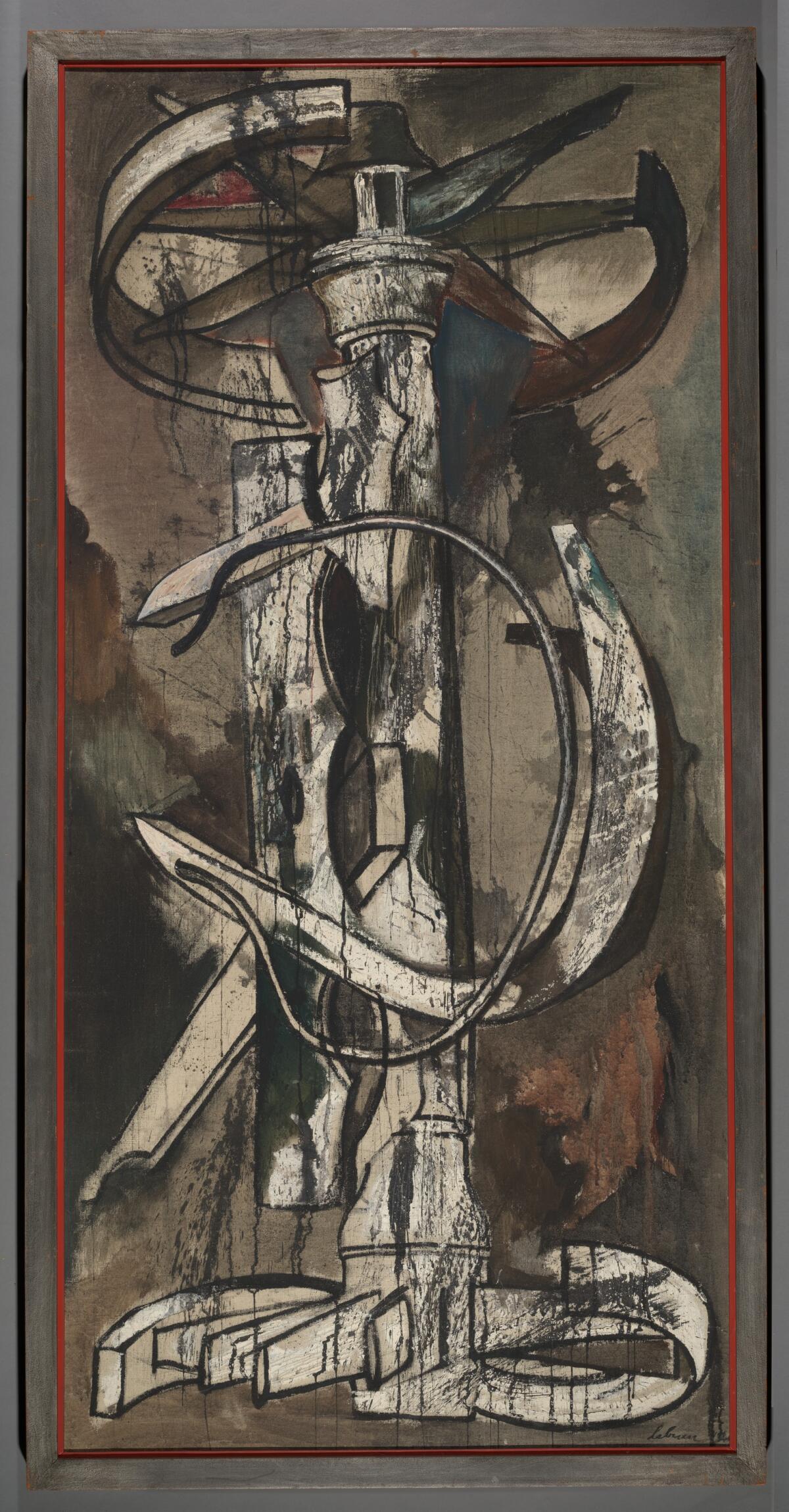
In 1951, New York’s Museum of Modern Art gave a solo exhibition to Rico Lebrun, an Italian-born painter and the most famous artist working in Los Angeles, the city he adopted in 1936. Widely shown and collected then, he is nearly forgotten today — but not quite.
San Diego-based collectors Sandra and Bram Dijkstra have donated Lebrun’s “Vertical Composition” (1945), currently on view in a Huntington exhibition of 17 WPA-era paintings from their collection. The Lebrun, a fine example of his Expressionist work, is a muscular semi-abstraction in black, white and brownish-gray. The palette is related to Picasso’s antiwar shriek, “Guernica,” while its industrial forms derive from a pile of ruined farm equipment the artist found in a field north of L.A.
The epic ruins of World War II are its obvious subject, conveyed through a variety of intriguing, compacted forms. The shape of an upright vehicle axle, nearly 6 feet tall, doubles as a Greco-Roman Doric column, which anchors the composition. Wrapped around it are curved forms, wiry and metallic, their composition looking strangely like a shattered hammer and sickle — an emblem of proletarian solidarity between agricultural and industrial workers in the Russian state, now torn asunder.
At the top, a jagged, broken form recalls the razor-sharp spokes of a Catherine wheel, a notorious public torture device common to medieval Europe. Lebrun would surely have known the monstrous tool from countless Italian Renaissance and Baroque paintings of martyred Saint Catherine of Alexandria — by Raphael, Caravaggio, Veronese, Artemisia Gentileschi, Bernardo Strozzi and dozens more. For good measure, he splashed the canvas with thinned dark paint, which runs down the surface like a photographic negative of blood.
LACMA acquired its first Lebrun painting just four years ago. With this Huntington acquisition, maybe it’s the start of a return to prominence — or at least a nod to the status of L.A.’s art history?
More to Read
The biggest entertainment stories
Get our big stories about Hollywood, film, television, music, arts, culture and more right in your inbox as soon as they publish.
You may occasionally receive promotional content from the Los Angeles Times.

